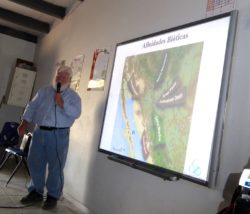Sky Island Environmental Education Experience: turning students into environmental stewards

The Madrean Archipelago (or Sky Island Mountain Range), a series of unique ecosystems that range from New Mexico and Arizona to Mexico, is one of the world’s global biodiversity hotspots. Yet most residents of the smaller towns in the region have never been in the Sky Islands and have little knowledge of the animals, plants, vegetation, or ecology.
That’s why Greater Good Charities is dedicated to educating local students about the natural history and amazing plants and animals living right in their backyard. The future of the environment begins with the education of today’s youth and their understanding of the natural environment in which they live.
The Sky Island Environmental Education Experience program started in April 2016 with visits to schools along the Río Bavispe on the east side of the Sierra el Tigre (Tiger Mountains). The schools visited were in the towns of Bacerac (1,342 inhabitants), Bavispe (710 inhabitants), Colonia Morelos (156 inhabitants), and San Miguelito (550 inhabitants).
The Secundaria Técnicas in Bacerac and Huásabas are regular middle schools. The other schools visited are telesecundarias, middle schools with one or two teachers in remote areas that receive most of their materials by satellite, through a TV monitor. In Bavispe, 45 elementary school students also attended the presentation. A total of 221 students and 18 teachers were reached during these environmental education visits.

Biodiversity presentation: In each school, a 45-minute Power Point presentation of the most exciting and colorful plants and animals observed on the Sierra el Tigre and Sierra Bacadéhuachi Expeditions was shown. Unique or new species were highlighted. The beautiful and clear images of landmarks and people from their region caught the students’ attention and interest. They enjoyed guessing animals or features in the slide show and asking questions. In each town, a student helped with the computer to advance the slides in the presentation.


Observing nature: One of the objectives was to encourage students to be better observers of things in the environment in which they live, and to appreciate that everything looks different when observed in different ways. The students first used binoculars to see plants and animals (and each other) at a distance. The binoculars are designed to see butterflies, allowing students to also use them to look more closely at the fabric in their clothes. Then the students looked at leaves, flowers, scorpions, butterflies, and ants through a binocular microscope. They were delighted with the color scales on the butterfly wing, the scorpion’s stinger, spines on ant bodies, and especially their own finger prints. They were also shown how scorpions reflect yellow-blue in ultraviolet light—completely different than their cryptic brown color in normal light.


Natural history of Sonora booklet: We prepared a 70 page natural history booklet in Spanish with essays on the different habitats in the State of Sonora, including the Sky Islands, written by specialists. It also includes information about pollinators, bats, and gardens to attract hummingbirds and butterflies. This booklet has some classroom activities on Monarch butterflies, bats, and others. It is well illustrated by beautiful, color photographs from the MDE program. The booklet was well received by teachers and students, and two copies were left at each school.
While students were taking turns looking through the microscope, the rest of the class read essays from the booklet on the life cycle of the monarch butterfly and the natural history of bats. After reading, students were asked questions from the text. Students who gave the right answer were rewarded with a Greater Good Charities t-shirt. A total of 50 t-shirts were left at the four middle schools visited.



